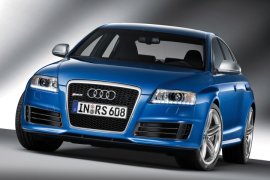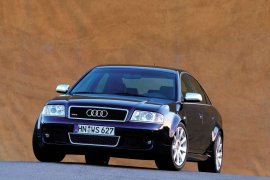AUDI RS6 Models/Series Timeline, Specifications & Photos
First production year: 2002
Engines: Gasoline
The third generation of the Audi A6 was launched in 2004 but it wasn't until 2008 when the most powerful version appeared: the RS6. It was available as station-wagon in 2008 and, in 2009, the RS6 sedan was shown.
At the time of its launch, the RS6 was the most powerful Audi ever produced. The big, 2-tone barge, was one of the fastest four-door sedans on the Earth and it was aided by a Lamborghini V10 engine. But it wasn't only about the power under the hood.
The RS6 had some subtle differences from the regular A6. The front bumper featured larger air-intakes in the lower side and a taller grille that went down from the hood to the front lip-spoiler. The silver rear-view mirrors caps were silver and in the back, two oval exhausts were installed underneath the bumper. The standard 19” light-alloy wheels were fitted as standard, while a larger, 20” set was available as an option.
Inside, it featured sport-bucket seats highly bolstered and with cut-outs in the upper side, just like those found in the race-cars to let the seat-belts harnesses went through. The flat-bottom steering-wheel was enhanced with the ES6 logo on its lower part. The interior was adorned with the finest of materials such as carbon fiber, aluminum, piano lacquer, leather and Alcantara.
The twin-turbo V10 engine was mated to a Tiptronic six-speed gearbox and sent its power to all four wheels, with a 40:60 torque bias.
In 2002 Audi introduced a car that could outrun the M5 from BMW or the W210 E55 AMG from Mercedes-Benz and produced it for just two years: the RS6.
The German automaker introduced the second generation of the A6 in 1997, but it waited another five years to launch the RS6 version. Audi kept that version on the assembly lines just for two years until it introduced a new generation of the A6.
While at first sight, it could've been mistaken with one of its lesser-powered siblings, a keen eye for detail would've noticed the flared wheel arches, the lower stance, and the unique bumper. As a signature element of design, the automaker installed silver door mirror caps. In addition, at the back, Audi installed a spoiler on the trunk lid and two oval-shaped exhausts that peaked from under the bumper.
The cabin featured high-bolstered bucket seats at the front with their seatbacks embroidered with the RS6 logo. The same badge was noticed on the lower side of the three-spoke steering wheel and inside the tachometer in the instrument panel. But Audi considered that its cars had to be luxurious, so it used leather upholstery and wood trims on the dashboard, door cards, and center console. In the back, the bench was wide enough to accommodate three people, but the tall transmission tunnel limited the legroom for the middle-seated passenger.
But the most significant part of the car was hidden under its skin, where Audi installed a twin-turbo 4.2-liter V8 mated to a five-speed automatic gearbox with manual override. Power went into all corners via an active center differential and a Torsen rear one.

